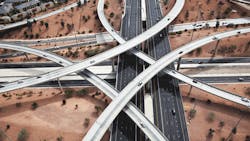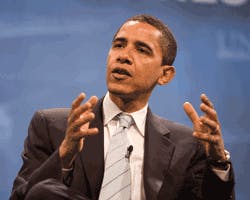You Are Your Infrastructure’s FUTURE
With the President joining the discussion of a new multi-year highway program, the once-distant prospect of Congress passing legislation before the current program expires at the end of September now seems real.
In late February President Obama called for the creation of a $302 billion, four-year highway program to be paid for largely through tax reforms.
"Too many construction workers are looking for jobs when we have ports that need to get ready for modern supertankers, when we have 100,000 bridges old enough to qualify for Medicare, and when we go through a winter like this when roads are wrecked and full of potholes all across the country," Obama said.
A few weeks earlier, Rep. Bill Shuster (R-PA) chairman of the House Transportation and Infrastructure Committee, said he hoped a five- or six-year highway bill will take shape by this summer. He also ruled out fuel tax hikes because of the fragile economy, noting then that President Obama also was opposed to raising fuel taxes.
Shuster said funding ideas under discussion include a tax on vehicle miles traveled, selling more off-shore oil drilling rights, and repatriating profits from American companies that are keeping them in foreign countries to avoid taxes.
Shuster later endorsed tax reform legislation introduced by Rep. Dave Camp (R-MI), chairman of the House Ways and Means Committee, the same week the President made his highway plan announcement.
That legislation would reduce the number of tax brackets, shrink business write offs, limit mortgage reductions and repeal other homeowner deductions. Under Camp's bill, $126.5 billion of the money raised by these changes would be dedicated to the Highway Trust Fund for eight years.
However, Camp's proposal has garnered no support—and some outright opposition—from Republican leaders in the Senate and House other than Shuster.
Although in the past conventional wisdom has held that a transportation bill couldn't be passed in an election year, the pressure is on this year because the Congressional Budget Office estimates the Highway Trust Fund will dry up no later than September 30.
In fact, Congress has been supplementing Trust Fund shortfalls in recent years with $55 billion in transfers from the general fund, with a transfer of about $10 billion for fiscal year 2014 alone.
If recent history is a guide, there is a good chance that freight needs will receive the attention they deserve in any new program—assuming that the industry chooses to make its voice heard early in the process.
"It is still the right and privilege of American citizens and companies—shippers, carriers and intermediaries—to speak up and be heard," says Bruce Carlton, president of the National Industrial Transportation League (www.nitl.org). "Let your congressman and senators know how you think, especially in this pivotal year in which we must pass a new highway bill."
The most recent highway bill enacted in 2012, the Moving Ahead for Progress in the 21st Century Act (MAP-21), was a two-year stopgap measure to keep the highway program going after it became evident a more ambitious multi-year plan could not be passed.
Although taxes were not increased, the legislation authorized $109 billion in spending in highway construction and maintenance.
MAP-21 also directly addressed issues surrounding the movement of freight for the first time. It called for creation of a national freight policy and the establishment of a 27,000-mile designated freight network of highways to help better target funding for infrastructure projects. In addition, a study of the contentious issue of truck sizes and weights mandated by the legislation is due in November.
Industry Input for Congress
Under MAP-21, a 47-member industry advisory committee was charged with producing recommendations for a National Freight Policy to be delivered to the secretary of transportation and Congress.
Another group, the Panel on 21st Century Freight Transportation made up of members of Congress, delivered a report in late 2013 detailing a program to address freight needs.
That panel urged creation of multimodal freight policy and identification of projects of national and regional significance and securing appropriate dedicated, sustainable funding sources for it.
Just exactly what those funding sources should be was not discussed, and that has been the roadblock to developing a new highway program for some time.
Money with the Mouth
Everyone agrees that America's infrastructure needs must be addressed—getting agreement on how to fund them is nearly impossible. When it comes to hiking fuel taxes, as the President and Rep. Shuster's remarks show, that is considered ballot box poison.
Other proposed solutions range from increased public-private partnerships (a fancy phrase for tolls) to a Vehicle Miles Traveled (VMT) tax, which is being experimented with in Oregon.
An intriguing proposal last November from Sen. Mike Lee (R-UT) and Rep. Tom Graves (R-GA) would gradually replace federal funding of transportation projects with block grants to states. Their bill garnered no support from Democrats and has no chance of being passed.
Last November Sens. Mark Warner (D-VA) and Roy Blunt (R-MO) resuscitated the idea of creating a national infrastructure funding bank. That bill attracted some bipartisan support in the Senate but if enacted would provide only $10 billion and was intended solely to meet projected shortfalls in the Highway Trust Fund.
Sen. Barbara Boxer (D-CA), chairman of the Senate Environment and Public Works Committee, advocates meeting the shortfall by switching the fuel tax from its current status as a retail levy charged at the pump to a wholesale sales tax charged further up the line from the consumer, an approach similar to that taken in Virginia under former Gov. Robert McDonnell.
The old argument in support of fuel taxes is that they represent a true users' fee—only those who use the highways pay for their construction and maintenance. In addition, fuel tax supporters say they are long overdue for a hike because they haven't been increased at the federal level in more than two decades.
Stay with Gas Tax?
Every year the NITL polls its members about infrastructure funding, most recently last November. "We've had absolutely consistent results for the past five years," Carlton says. "Every time they come back with the answer: Let's stay with the gas tax—let's increase it to some level that makes sense, and let's index it for inflation."
He notes this is consistent with the positions taken by other major business groups, including American Trucking Associations, National Association of Manufacturers and the U.S. Chamber of Commerce.
Carlton notes, "The gas tax works if it's properly structured. It has the advantage of being an extremely simple and administratively inexpensive user fee. There are a lot of other competing and constructive proposals to fund infrastructure investment but they are all much more complicated. The gas and diesel fuel taxes are really easy: You put the nozzle in the tank, and you squeeze the trigger."
One recent proposal that gathered support comes from Rep. Earl Blumenauer (D-OR) and would raise federal fuel taxes by 15 cents per gallon, to be phased in over three years. He estimates that this will raise $170 billion in revenues over a period of 10 years.
ATA lent its support to the Blumenauer proposal, as did the U.S. Chamber, UPS, Amalgamated Transit Union, Associated General Contractors of America and the American Society of Civil Engineers.
Although NITL did not officially take a position, Carlton says, "I know that if I were to put that to League members I could guarantee the result would be that they would say, ‘yes, we do support it' because it really matches up with their thinking.'"
Political Hot Potato
Some House Republicans pronounced Blumenauer's tax hike "dead on arrival" and President Obama avoided any mention of fuel tax increases when he unveiled his own proposals, preferring to opt for funding it by closing unspecified tax loopholes.
However, the quandary still remains about how you can manage to sustain infrastructure maintenance and improvements over the long term without hiking fuel taxes.
"Politically, we know it's a tough challenge to get elected members of Congress to vote to increase a tax," Carlton admits. "But we are telling them, ‘look, we've got your back. We will support you, we will promote it, we will defend it as a fair and equitable way to raise the money that we all need and we all benefit from, to build roads, to do the maintenance and repair.'"
In the meantime, the nation's acute infrastructure needs continue to grow. But those with a significant stake in an efficient national supply chain can make their voices heard.
"Other countries are investing in their infrastructure at a much higher rate than we are. We do run the risk of our economy turning into a second-class economy as we look ahead to 2020 and beyond," said Leslie Blakey, president of the Coalition for America's Gateways and Trade Corridors, during the November NIT League annual meeting in Houston.
"This is an important message to get across to Congress because as we all know it takes years to build a transportation infrastructure project," she added. "When we are talking about infrastructure projects we have to look far into the future about what we're going to do and how we're going to do it."
The fact that these projects don't pay off any sooner than 12 years or more has proven to be the biggest barrier to recruiting carrier and third-party logistics executives. Too many of these practitioners are focused on being able to meet next quarter's payroll or financial targets set by upper management to concern themselves with what will happen a dozen years from now.
Cost of Doing Nothing
If Bill Eisele of the Texas A&M University Transportation Institute is right, you have plenty of reason to be concerned. Speaking at the same NITL panel presentation he discussed the institute's annual Urban Mobility Report and recent research with significant implications for the supply chain. For data gathered in 2012 the transportation researchers estimated total congestion costs in the United States were $121 billion, with about $27 billion of that stemming from lost transit time and fuel wasted by the trucking industry.
More important, according to Eisele, are the enormous costs incurred by shippers and carriers in the planning required to avoid those delays, such as adding in extra time for shipments and route planning. "Essentially, congestion is growing no matter what urban area in the U.S. you are operating in," he said.
Blakey and others note there was some good news in the passage last year of inland waterway infrastructure legislation in a bipartisan effort led by T&I Committee Chairman Shuster and Democrat Senator Boxer.
The success of that cooperation across the aisle raised hope that we may be able to return to the former days when the crafting of transportation infrastructure programs was regarded as a welcome bipartisan task instead of falling victim to ideological gridlock.
David Sparkman is founding editor of ACWI Advance (www.acwi.org), the newsletter of the American Chain of Warehouses Inc., and a member of MH&L's Editorial Advisory Board.
How to be Heard on Infrastructure Issues
It is vital for members of Congress, federal officials and local and state officials to hear from logistics practitioners when they're setting transportation policy and planning infrastructure projects.
As a wise man once observed, if you don't talk to them, someone else will. That is one of the reasons why we have seen a proliferation of bicycle lanes and "traffic calming" projects in many localities, while others, to save costs, have switched from pavement to gravel as their roads crumble under the wheels of the trucks their local economy depends on.
When it comes to communicating with Congress, NIT League president Bruce Carlton says it pays to be direct: "Write them a letter, send them a fax, give them a call at the office and tell them what you think."
Another approach is to zero in on the members and staff of the Senate and House committees that are charged with drafting the legislation. Even better is if the members who represent your district and state sit on those bodies. "Let the committee leadership and members know what you think. It's their job to craft the bill and sell it," Carlton says.
A list of members of the House Transportation & Infrastructure Committee can be found here: http://transport.house.gov/about/membership.htm. Members of the Senate Environment & Public Works Committee are listed here: http://www.epw.senate.gov/public/index.cfm?FuseAction=Members.Home. Members of the Senate Commerce Committee, which also has jurisdiction over the highway program, can be found here: http://www.commerce.senate.gov/public/index.cfm?p=CommitteeMembers
"We urge everyone in the industry to be active and to be a voice on this issue," Emily Fishkin, director of infrastructure initiatives for the American Society of Civil Engineers, said during a panel presentation at the NITL annual meeting in November. "Members of Congress would much rather hear from business owners and businesspeople who are their constituents than from us."
She also encouraged executives who are members of industry associations which hold Washington fly-ins to take advantage of those opportunities. "You also can meet with members when they are back in their districts. It is important to emphasize that it is about jobs, and it is about a lot more than just construction jobs."
Industry associations also can be a good source of talking points and other information to help you back up your positions. Fishkin's group publishes an annual infrastructure report card that you can access here:
www.infrastructurereportcard.org. Another useful tool is the annual Urban Mobility Report from the Texas A&M Transportation Institute, available here: http://mobility.tamu.edu/ums/ (The new one containing 2013 data should be available when this article is published).
Another excellent source of up-to-date information on the progress of legislation and other developments is the Coalition for America's Gateways and Trade Corridors, made up of more than 60 representative organizations, including state DOTs, metropolitan planning organizations, ports and engineering firms: www.tradecorridors.org/
When it comes to the state and local level, it is just as important, if not more, for transportation planners to hear directly from business. "These are open processes; they are not happening in a complete vacuum—they have public meetings and hearings and folks need to show up," Carlton says. "The message is that they can't read your mind. It is through individual contact and local Chambers of Commerce and other business associations that they channel the thinking of the population."
Fishkin makes a similar point: "Join a local coalition. There are lots of these groups that are tackling these different issues in transportation. Leverage what they are doing and get involved."
It's not that hard, according to Carlton. "I'm old fashioned, I really believe in picking up the phone and calling these folks to let them know what you think."


